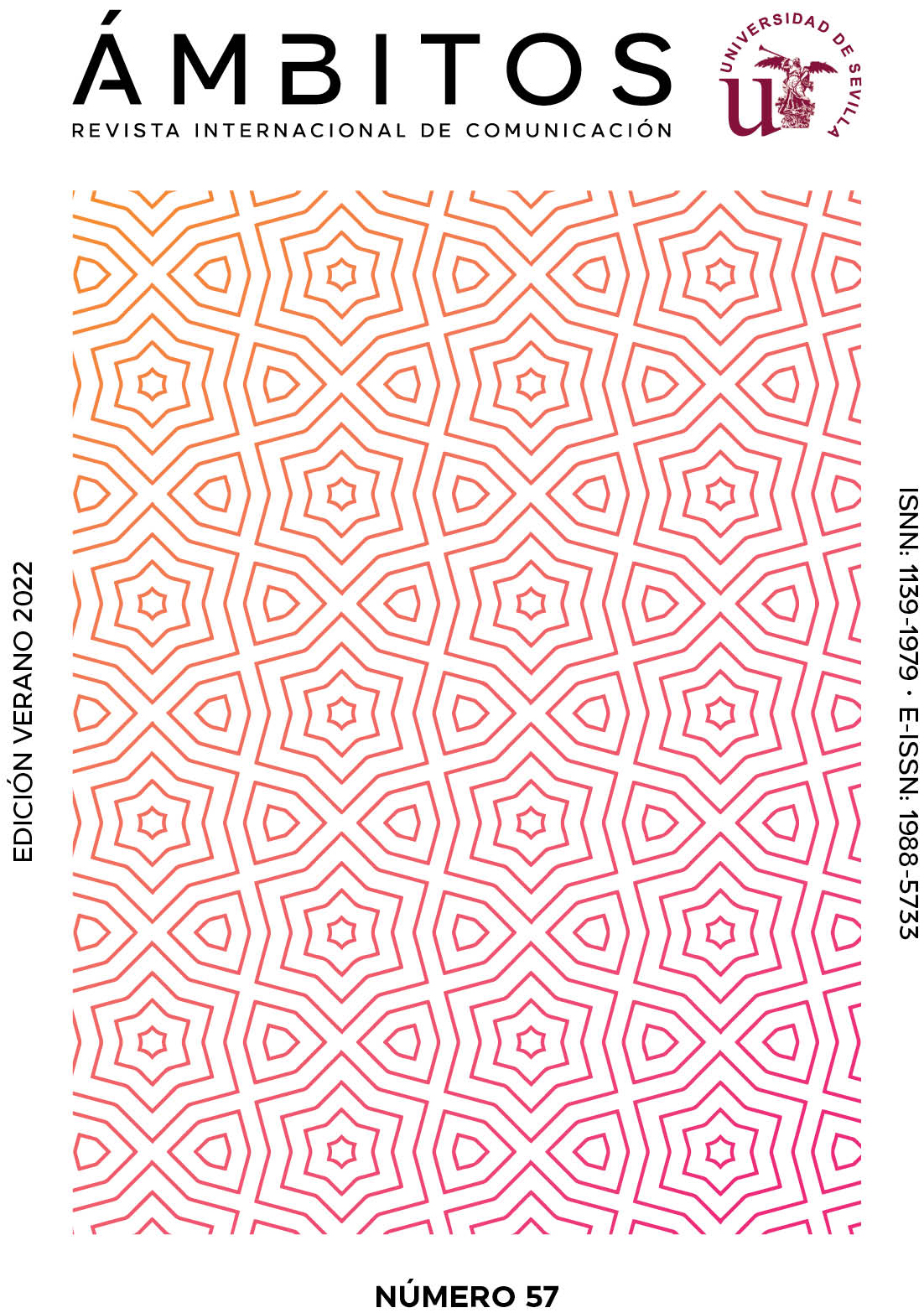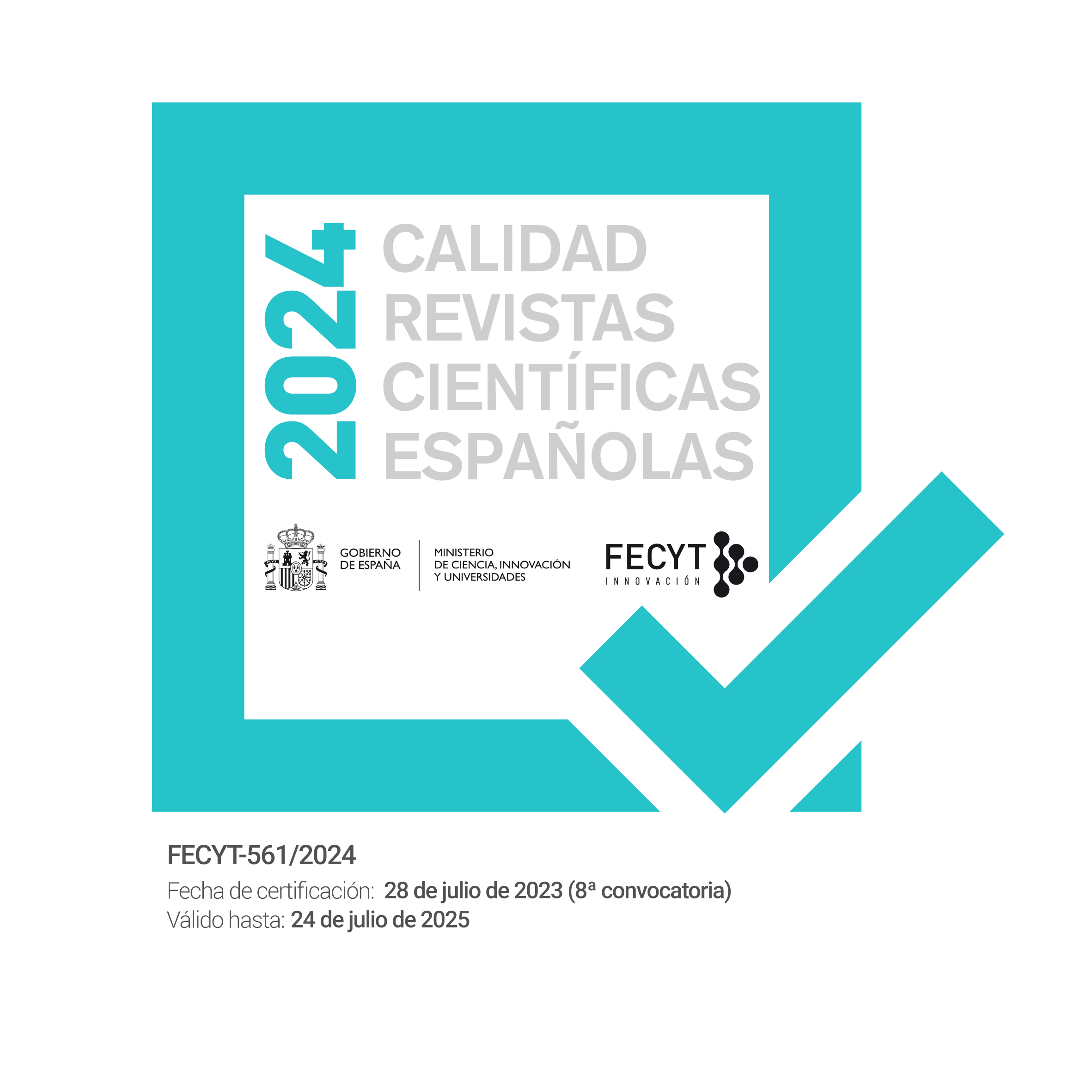Analysis of the comments to a presidential pronouncement on COVID-19 in Brazil, made on March 23, 2021
DOI:
https://doi.org/10.12795/Ambitos.2022.i57.08Keywords:
social network analysis, qualitative analysis, cyberaggression, disinformation, youtubeAbstract
This work analyzes the comments on the messages about a certain event on social networks. In this case, the denialist messages of President Jair Bolsonaro, minimizing the consequences of the COVID-19 pandemic on the Brazilian population. It analyzes how these attitudes work as a system of manipulation and indoctrination that is imposed on the behavior of the followers of a certain political group. Social networks have become an important means of communication for these groups that use them as an alternative to traditional means of communication. Creating spaces and acquiring a visibility that they would not have before in traditional media. The work methodology was based on computer programs for computer-assisted qualitative analysis. Being possible through the use of algorithms to reliably quantify large volumes of qualitative information, automating much of the data processing and saving time in the interpretation of texts through the use of lexicometric analysis. Three communication channels were analyzed that define three different groups of comments that allowed to observe notable differences between the groups, while the official channel of the Planalto Palace was more critical and contradictions were evident with recurring words such as no and a liar, Jair’s channel Bolsonaro and the focus of Brazil were clearly defenders of the ideas propagated by Bolsonaro, in which there is a clear association with the word president, god and good time. It is concluded that individuals use social networks and express in their comments their mood and feelings of hatred depending on the type of channel they are using, thus in the channels of Bolsonaro or his followers their expression is more openly passionate.
Downloads
Metrics
References
Arendt, H. (1974). Los orígenes del totalitarismo. Taurus.
Azevedo, D. M.; Costas, R. K. S. y Miranda, F. A. N. (2013). Uso do Alceste na análise de dados qualitativos: contribuições na pesquisa em enfermagem. Rev. Enferm. UFPE on line. 7(esp), 5015-22. https://doi.org/10.5205/1981-8963-v7i7a11764p5015-5022-2013
Bernays, E. (2008). Propaganda. Melusina
Bresciani, E. (2018, 9 de agosto). Filho de Bolsonaro diz que marqueteiro de Trump vai ajudar seu pai, Eduardo Bolsonaro fará contatos com Steve Bannon durante a campanha. Epoca. http://glo.bo/3NpNzKc
Busón, C. (2020). La minería de opinión para el análisis del discurso de odio en las redes: Un estudio de caso sobre Paulo Freire en YouTube durante el periodo 2007-2019. Commons. Revista De Comunicación Y Ciudadanía Digital, 9(1), 119-159. https://doi.org/10.25267/commons.2020.v9.i1.5
Camargo, B. V. (2005) ALCESTE: um programa informático de análise quantitativa de dados textuais. En A. Moreira y A. Silva (Org). Perspectivas teórico-metodológicas em representações sociais (pp. 511-539). João Pessoa: UFPB. Editora Universitária.
Cunha, D. (2013). Violência verbal nos comentários de leitores publicados em sites de notícia. Calidoscopio, 11(3), 241-249. http://revistas.unisinos.br/index.php/calidoscopio/article/view/cld.2013.113.02
Del Río, C. M. (2020). Uso de software lexical: una revisión comparativa. Red Internacional de Investigadores en Competitividad, 13, 221-244.
Van Dijk, T. A. (2000). El discurso como estructura y proceso. Estudio del discurso: introducción multidisciplinar. Gedisa.
Van Dijk, T. A. (2002). El análisis crítico del discurso y el pensamiento social. Athenea Digital. Revista De Pensamiento E Investigación Social, 1(1), 18-24. https://doi.org/10.5565/rev/athenead/v1n1.22
Galvani, N. (2021, 26 de marzo). Manifestantes prestam continência a caixa de cloroquina; imagem viraliza. Diario de Pernambuco. https://bit.ly/3GH7G46
G1 (2021, 23 de marzo). No dia do recorde de mais de 3 mil mortes por Covid, Bolsonaro vai à TV para prometer vacinas. Globo. http://glo.bo/3x0cqyI
G1 (2020, 31 de mayo). Brasil registra 29.314 mortes e 514.849 casos confirmados de Covid-19, diz ministério. Globo G1. http://glo.bo/38LnaHW
Hoffman, D. S. (1996). The web of hate: Extremists exploit the internet. Anti-Defamation League.
Jucá, B. (2021, 21 de diciembre). Chip na vacina, “virar jacaré” e outros mitos criam pandemia de desinformação na luta contra a covid-19. El País. https://bit.ly/38UcsPx
Levine, R. V. (2003) The Power of Persuasion: How We’re Bought and Sold. Wiley
Londoño, E y Casado, L. (27/03/2021, 27 de marzo). A Collapse Foretold: How Brazil’s Covid-19 Outbreak Overwhelmed Hospitals. New York Times. https://nyti.ms/3wW3mcV
Lothaire, F. (2020, 22 de junio). Bolsonaro é único líder a manter discurso inadequado e “falta de respeito às vítimas”, diz Mandetta. RFI. https://bit.ly/3NT8Mwf
Machado, J. y Miskolci, R. (2019). Das Jornadas de junho à cruzada moral: o papel das redes sociais na polarização política brasileira. Sociologia & Antropologia, 9(3), 945-970. https://doi.org/10.1590/2238-38752019v9310
Marcotte, A (2018) Troll Nation: How the American Right Devolved Into a Clubhouse of Haters. Hot Books
Medina, E. y Moreno, J. (2019). Futuros creativos: estudiantes de comunicación audiovisual ante el diseño de contenidos televisivos. Ámbitos. Revista Internacional de Comunicación, 43(1), 7-26. https://doi.org/10.12795/Ambitos.2019.i43.01
Mendley, D. M. (2005). The Research Context and the Goals of Teacher Education. En M. Mohan y R. E. Hull (Eds.), Teaching Effectiveness (pp. 42-76). Educational Technology Publications.
Messenberg, D. (2017). A direita que saiu do armário: a cosmovisão dos formadores de opinião dos manifestantes de direita brasileiros. Sociedade e Estado, 32(3), 621-648. https://doi.org/10.1590/s0102-69922017.3203004
Nicoletti, G. (2015, 6 de noviembre). Umberto Eco: “Con i social parola a legioni di imbecilli”. La Stampa. https://bit.ly/3x1ISPN
OCDE (2000). Methodology for Case Studies of Organizational Change. Consultado en https://bit.ly/2IiAqWo
Pereira, C. y Coutinho, C. (2019). A Extrema Direita Adiciona o Neoliberalismo: O papel das mídias sociais no atual cenário político. Revista Cadernos Internacionais, 2019(2), 4-24. https://10.17771/PUCRio.CadRI.45949
Poland, B. (2016). Haters: Harassment, Abuse, and Violence Online. University of Nebraska Press.
Ratinaud, P. (2014, 3 – 6 junio) Visualisation chronologique des analyses ALCESTE: application à Twitter avec l’exemple du hashtag# mariagepourtous. [ponencia] 12es Journées internationales d’Analyse statistique des Données Textuelles. Paris Sorbonne Nouvelle–Inalco, París, Francia. http://lexicometrica.univ-paris3.fr/jadt/jadt2014/01-ACTES/46-JADT2014.pdf
Ratinaud, P. (2016). Étude d’un large corpus textuel avec IRaMuTeQ: Twitter et le hashtag# mariagepourtous. Les représentations sociales. Théories, méthodes et applications. De Boeck Supérieur, 107-112.
Reagle, J. (2015). Reading the Comments: Likers, Haters, and Manipulators at the Bottom of the Web. MIT Press.
Reed, M. (2016). A Study of Social Network Effects on the Stock Market. Journal of Behavioral Finance, 17(4), 342–351. http://doi.org/10.1080/15427560.2016.1238371
Reich, W. (1980). Psicología de masas del fascismo. tercera edición, revisada y aumentada. Bruguera.
Reig, R. (2000). Medios de comunicación y poder en España. Prensa, radio, televisión y mundo editorial. Paidós.
Reinert, M. (1993). Les «mondes lexicaux» et leur «logique» à travers l’analyse statistique d’un corpus de récits de cauchemars. Langage et société (Maison des Sciences de l’Homme), 66, 5-39.
Resende, T.; Fernandes, T. y Gielow, I. (2020, 31 de mayo). Bolsonaro usa helicóptero e anda a cavalo para prestigiar ato na Esplanada contra STF e Congresso. Folha UOL. https://bit.ly/3x6DECn
Ribeiro, L. G. M., Lasaitis, C. y Gurgel, L. (2016). Bolsonaro Zuero 3.0: Um estudo sobre as novas articulações do discurso da direita brasileira através das redes sociais. Anagrama, 10(2). https://bit.ly/3aoZLw8
Rittner, D. (2020, 19 de diciembre). Pressa da vacina não se justifica. Valor econômico. http://glo.bo/3GB9Cvd
Sarrica, M.; Mingo, I., Mazzara, B. y Leone, G. (2016). The effects of lemmatization on textual analysis conducted with IRaMuTeQ: results in comparison. 13ème Journées internationales d’Analyse statistique des Données Textuelles. https://bit.ly/3Na2Ej7
Sayago, S. (2014). El análisis del discurso como técnica de investigación cualitativa y cuantitativa en las ciencias sociales. Cinta moebio, 49, 1-10. http://dx.doi.org/10.4067/S0717-554X2014000100001
Silva, A. B., Brites, C. M., Oliveira, E. D. y Borri, G. T. (2014). A extrema-direita na atualidade. Serviço Social & Sociedade, 119, 407-445. https://doi.org/10.1590/S0101-66282014000300002
Souza, M., Wall, M., Thuler, A., Lowen, I. y Peres, A. (2018). O uso do software IRAMUTEQ na análise de dados em pesquisas qualitativas. Revista da Escola de Enfermagem da USP, 52. https://doi.org/10.1590/s1980-220x2017015003353.
Downloads
Published
How to Cite
Issue
Section
License
Copyright (c) 2022 Carlos Busón, Alexis Carbalí, Katherin Pérez Mendoza, Ángeles Diez Rodríguez

This work is licensed under a Creative Commons Attribution-NonCommercial-ShareAlike 4.0 International License.
Ámbitos. Revista Internacional de Comunicación is an open access journal, which means that all content is freely available at no charge to the user or their institution. Users may read, download, copy, distribute, distribute, print, search or link to the full text of articles, or use them for any other lawful purpose, without seeking prior permission from the publisher or author. This definition of open access is in accordance with the Budapest Open Access Initiative (BOAI).

Unless otherwise noted, all content in the electronic edition is distributed under a "Creative Commons Attribution-NonCommercial-ShareAlike 4.0 International License". You can consult the informative version and legal text of the licence here. This should be expressly stated in this way where necessary.
In case of acceptance of the manuscript, the authors cede the rights of the work for its publication to Ámbitos. Revista Internacional de Comunicación under the Attribution-NonCommercial-ShareAlike 4.0 International license contract (CC BY-NC-SA 4.0). The authors retain copyright and third parties are authorised to copy, distribute and make use of the work, provided they comply with the terms and conditions set out in the licence
- Cite the authorship and the original source of publication (journal, publisher and URL of the work).
- Do not use them for commercial purposes.
- If you remix, transform or create from the material, you must release your contributions under the same license as the original.
More information can be found at https://creativecommons.org/licenses/by-nc-sa/4.0/deed.es
- Abstract 524
- PDF (Español (España)) 107


















